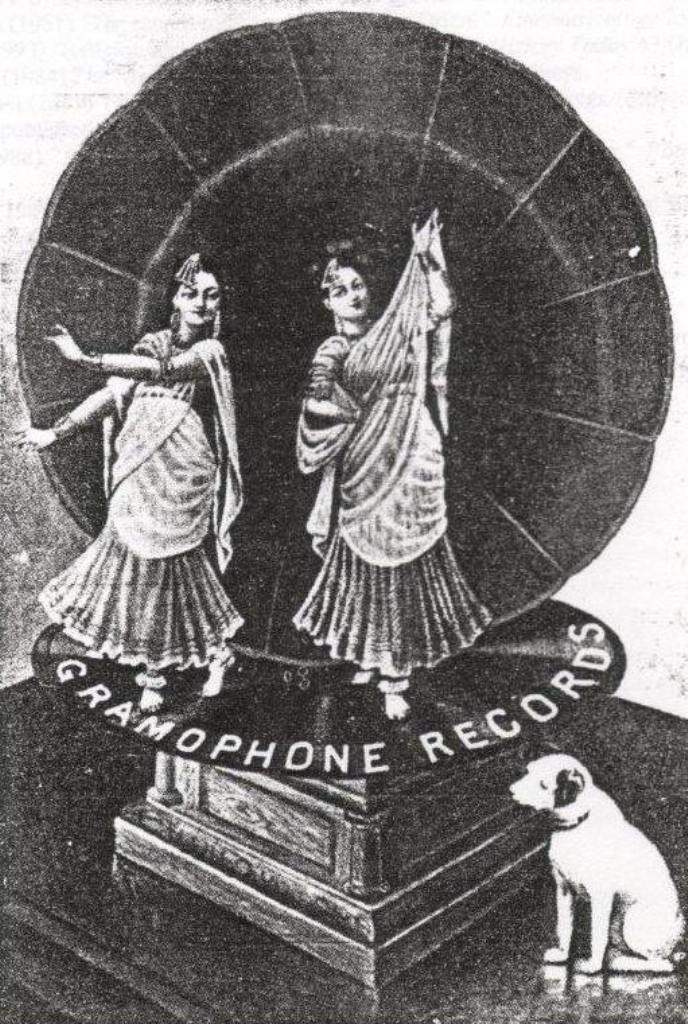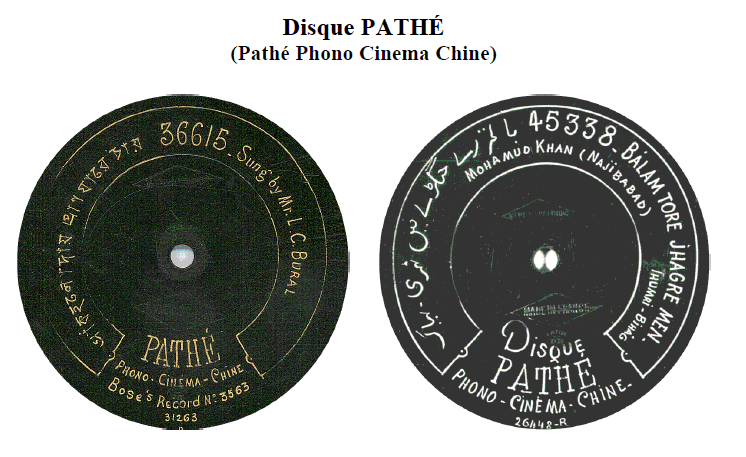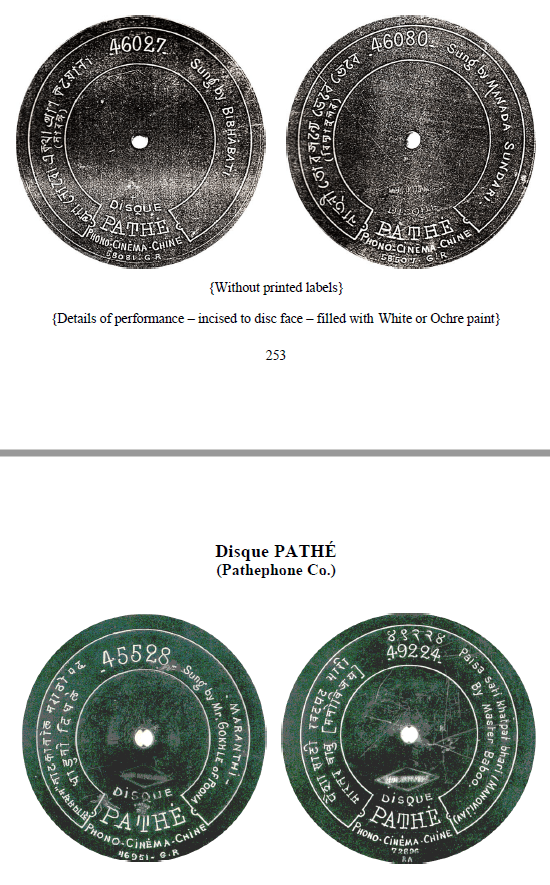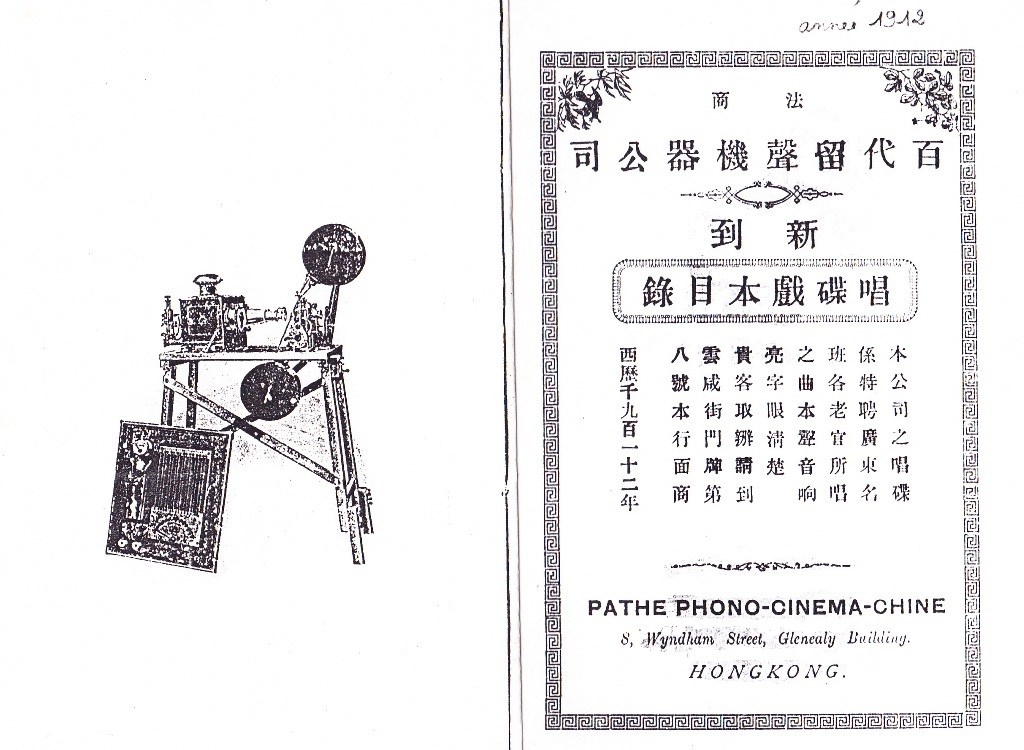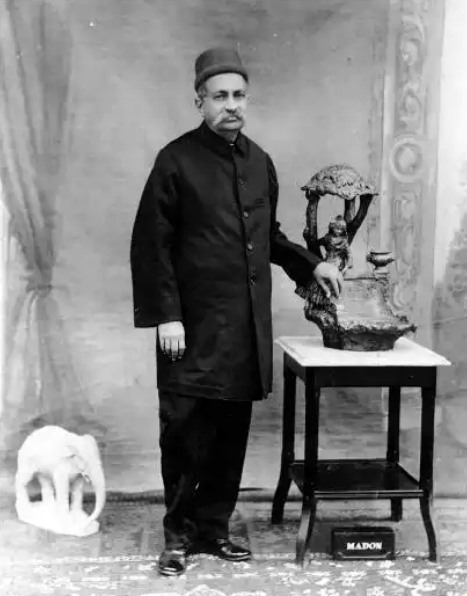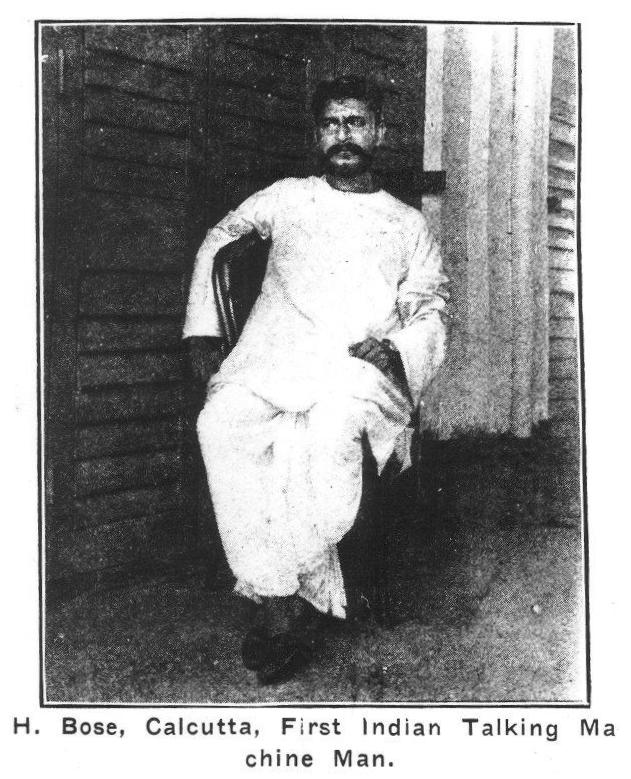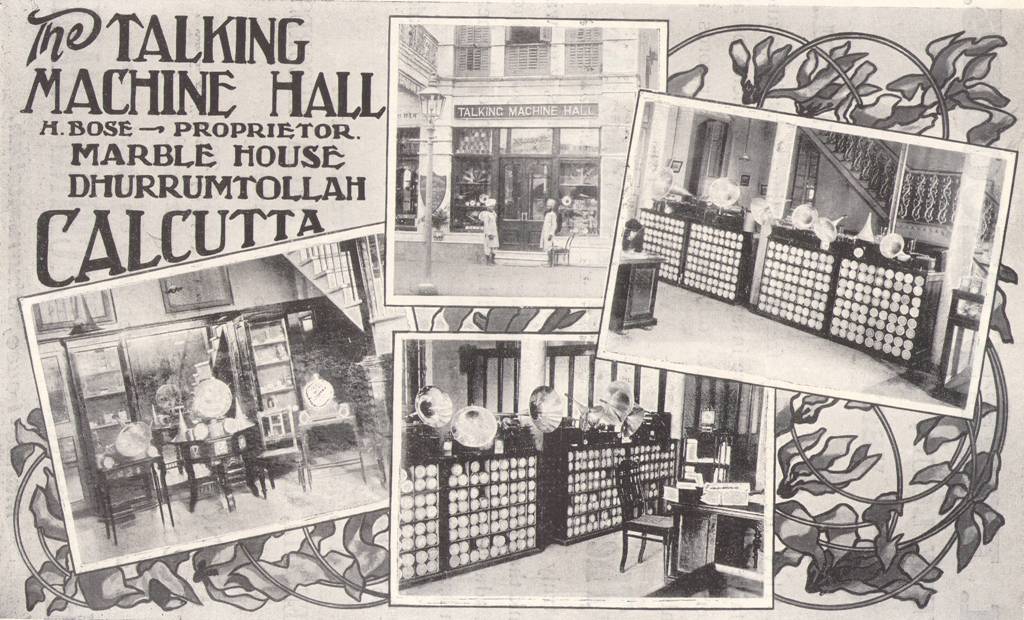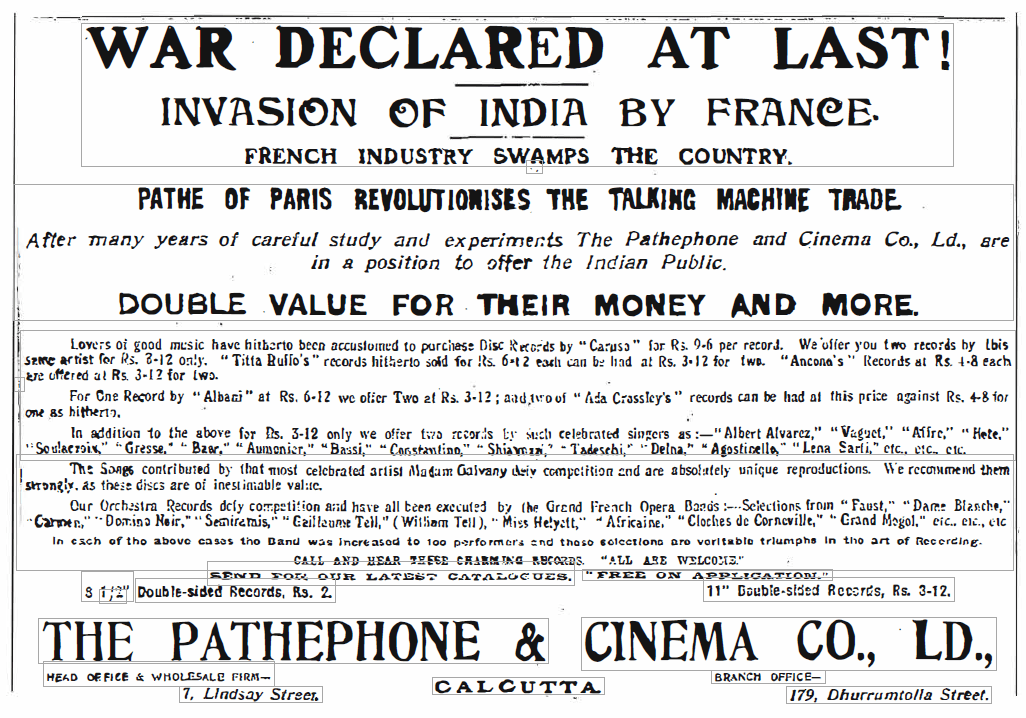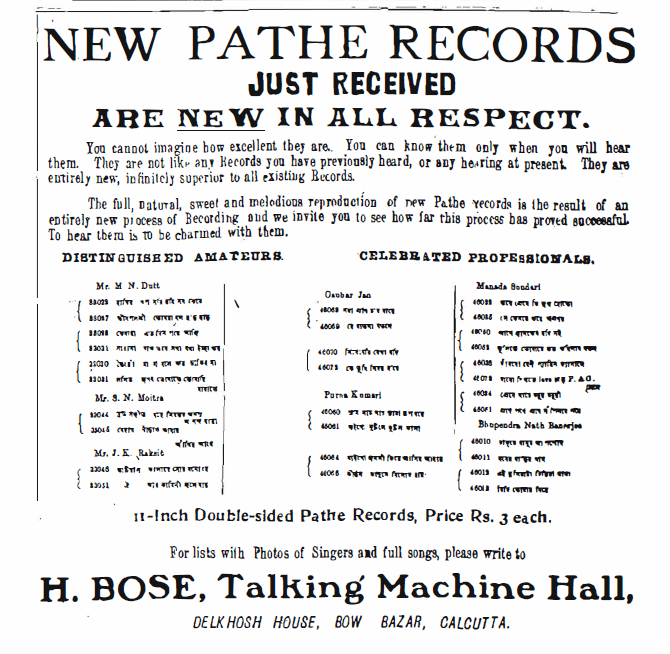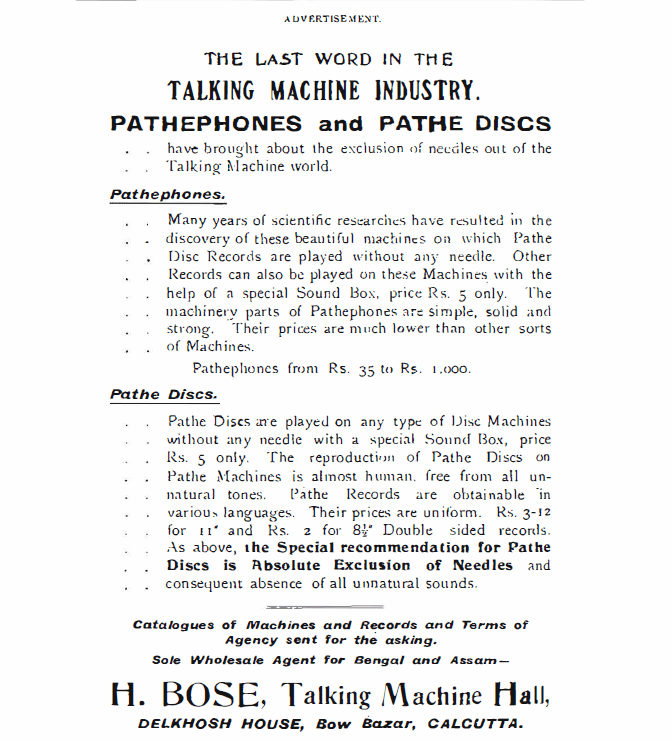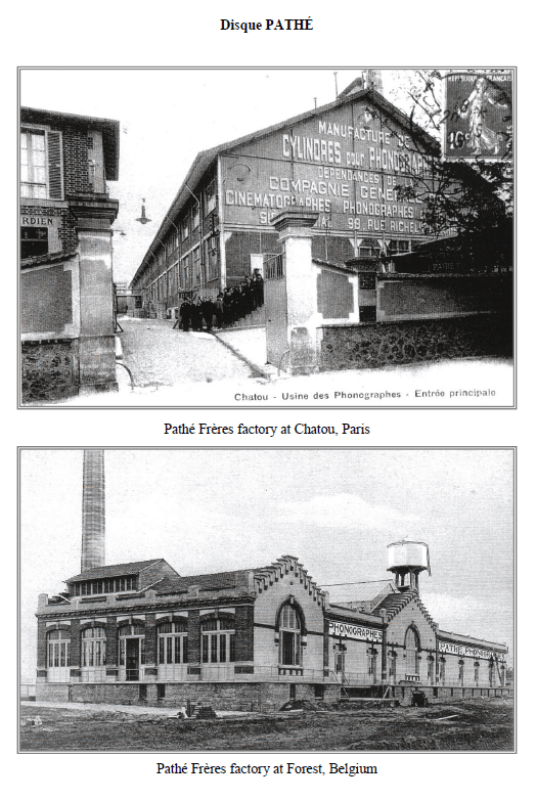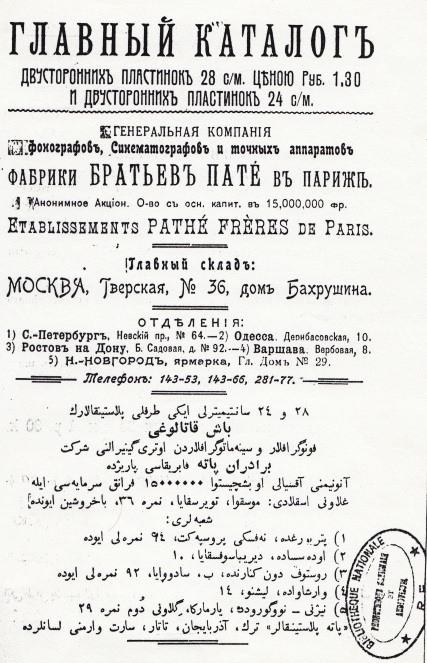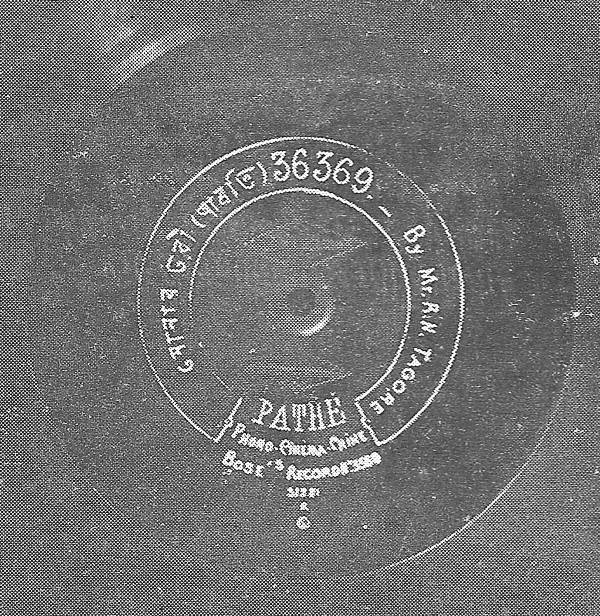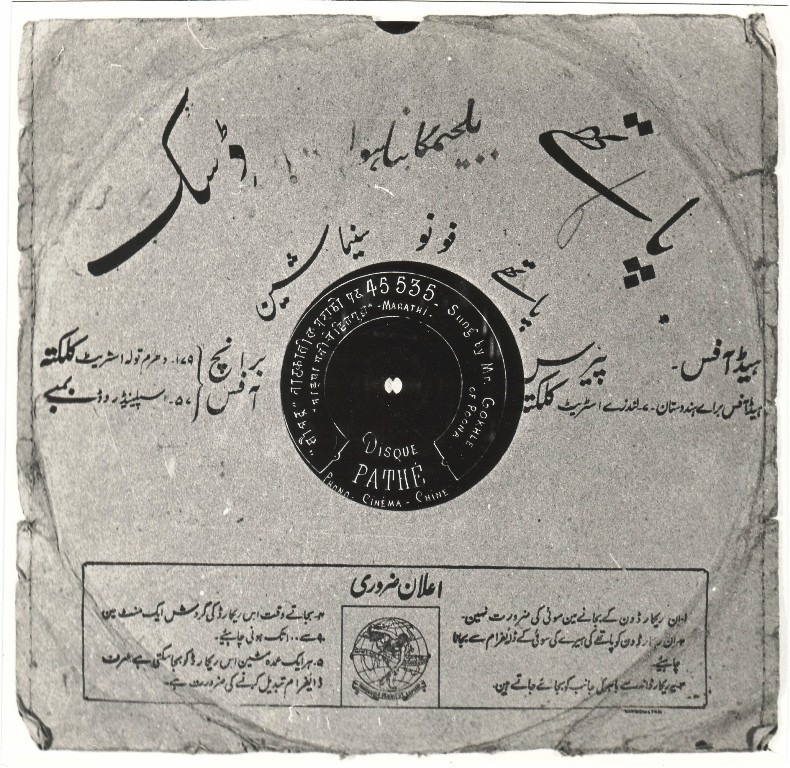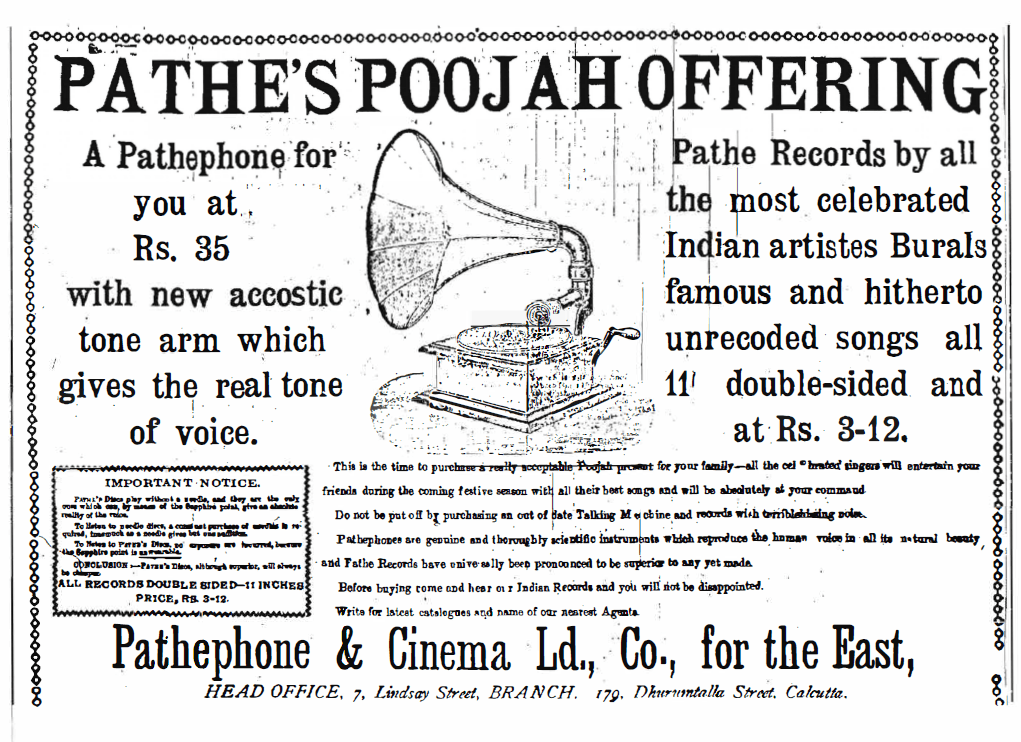PATHÉ and PATHEPHONE
READING INDIAN RECORD LABELS – Part Five
By Michael Kinnear
Disque PATHÉ
(Pathé Phono Cinema Chine)
H. Bose, Calcutta
Pathé Phono Cinema Chine, Calcutta
Proprietor:
Cie. Gle. de Phonographes, Cinématographes et Appareils de Precision, 98 Rue de Richelieu, Paris
(renamed) Cie.Gle. des Établissements Pathé Frères, Phonographe et Cinématographe, 30 Boulevard des Italiens, Paris
Agent:
H. Bose, 62 Bow Bazar, Calcutta
Hague, Moode & Co., Lucknow and Delhi
Pathé Phono Cinema Chine, 7A Lindsay Street, Calcutta
Manufacturer:
Cie .Gle. de Phonographes, Cinématographes et Appareils de Precision Chatou, Seine-et-Oise, Paris. (Cylinders, Discs)
Phonographes Pathé, Belge, Forest, Belgium (Discs)
Series: 36,000 (Black) (H.Bose’s Records) [PATHÉ]
3500 (Black) (H.Bose’s Records)
5000 (Black) (Hague, Moode & Co.)
45,000 (Black) (Hague, Moode & Co.)
49,000 (Black) (Pathé Phono Cinema Chine)
The Pathephone India Co., Ltd., Calcutta and Bombay
Proprietor:
Cie. Gle. de Phonographes, Cinématographes et Appareils de Precision
Cie.Gle.des Établissements Pathé Frères, Phonograph et Cinémaytographe, 98 Rue de Richeleau, Paris
Agency:
The Pathephone and Cinema Coy., 7 Lindsay Street, Calcutta 1908-1911
The Pathephone Co., Ltd., 7 Lindsay Street, Calcutta 1911-1912
The Pathephone India Co., Ltd., 7 Lindsay Street, Calcutta 1912-1913
The Pathéphone India Co., Ltd., 11 Churchgate Street, Bombay
The Pathephone India Co., Ltd., 17/1 Chowringhee, Calcutta 1913-1914
The Pathephone India (Bombay) Co., 50 Churchgate Street, Bombay,1914
Pathé India, Ltd., Sprott Road, Ballard Estate, Bombay 1919-1930
Manufacturer:
Cie. Gle. de Phonographes, Cinématographes et Appareils de Precision
Cie.Gen. des Établissements Pathé Frères, Phonographe et Cinématographe Chatou, Paris and Forest, Belgium
Series: 33,000 (Black); [PATHÉ]
45,000 (Black)
46,000(Black)
49,000 (Black)
‘PATHÉ‘ or ‘PATHEPHONE’ as a disc record label in India is one of the rarest of disc records to feature an Indian repertoire. The first PATHE disc records with an Indian Repertoire were placed on the market in India in March 1908, and although these PATHE disc records were the first disc records to bear the name – the actual recordings had been in circulation in India – as cylinder recordings – some possibly dating back to as early as 1900 that had formerly been ‘private’ recordings taken by Hemendra Mohan Bose. Pathé Frères of Paris had been active in India since the late 1890’s although their primary interest in India was with the sales and distribution of cinema equipment, for which Calcutta was but one of their branch offices in Asia with other sales and distribution offices were located at Singapore, Hong Kong, Shanghai and Tokyo.
The business relationship between H. Bose and Pathé Frères of Paris is a complex and interesting story which deserves to be narrated separately, particularly in that Hemendra Mohan Bose may be considered to be the founder of the ‘indigenous’ sound recording industry in India, so with this article we shall be concentrating upon the activities of Pathé Frères of Paris and its corporate interests in India as a separate entity in the context of the sound recording industry of India.
Charles and Emile PATHÉ
- Charles Pathé
- Emile Pathé
Charles Pathé had decided to enter the phonograph trade in 1894 after witnessing an exhibition of an Edison phonograph at a fair in Vincennes, near Paris, and having also acquired an Edison Kinetoscope began to develop a business which soon ran short of capital and might have folded were it not for his brother Emile who came to the rescue with financial support which soon led to the foundation of a firm named Pathé Frères, on about 13 June 1895 with a capital of 4000 francs.
On 28 December 1897, the firm of Pathé Frères was re-organized into a new company named ‘La Compagnie Générale de Cinématographes, Phonographes et Pellicules’ with a capital of 1,000,000 francs. This company was the fountain-head of a number of businesses and companies to be associated with the name ‘Pathé ‘ which featured a ‘cock’ as its trademark. With the headquarters of the company located at 98 rue Richelieu, and sales rooms at 26 Boulevard des Italiens, Paris, a studio and workshops at Vincennes and a factory at Chatou, on the eastern outskirts of Paris.
By 10 December 1900 the original company known as ‘La Compagnie Générale de Cinématographes, Phonographes et Pellicules’ had amalgamated with yet another company named ‘La Manufacture Francaise d’Appariels de Precision’ to become known as ‘La Compagnie Générale des Phonographes, Cinématographes et Appareils de Précision’ that is commonly called Pathé Frères of Paris, by which time the organization had already established a presence in Asia in the name of Messrs. Pathé Phono Cinema Chine Co., with the main office located in Shanghai, and branches in Hong Kong and Singapore.
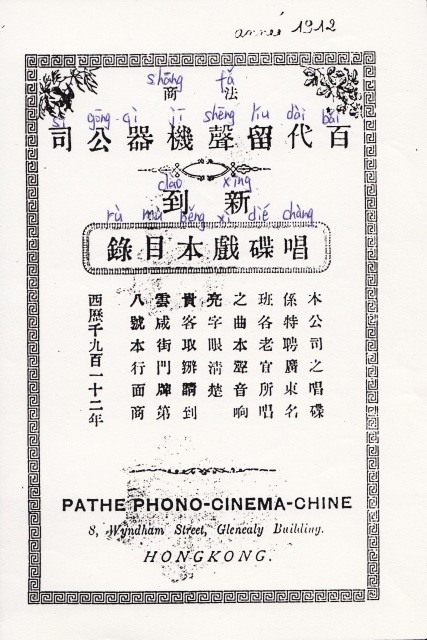 Pathé-Phono-Cinema-Chine, Chinese Catalogue, 1912
Pathé-Phono-Cinema-Chine, Chinese Catalogue, 1912
184 Pages
PDF Download – Pathe Phono-Cinema-Chine, 1912 – CATALOGUE
As far as is known Pathé Frères did not have their own branch office established in India until 1905, but were represented through J.F. Madan & Co., 5 Dharamtalla Street, Calcutta, for cinema products and through H. Bose, 62 Bow Bazar Street, Calcutta for their phonograph products.
A representative agent of Pathé Frères of Paris is thought to have been residing at 55 Bentinck Street, Calcutta, in rooms above the English Masonic Hall at the same address. The identity of this agent has not been discovered, but by 1905, Pathé Frères, and The French Motor Car and Electric Co., are known to have been operating from the Masonic Building.
J.F. MADAN
Jamshedji Framji Madan, J. F. Madan and Co
Jamshedji Framji Madan had a number of business interests in Calcutta and elsewhere of which his cinema and theatrical businesses were amongst his most important. J. F. Madan & Co.’s main offices were located in the same building at 5 Dharamtalla Street, that included the Corinthian Hall, the artists of which had made a substantial contribution to the first recording sessions held by The Gramophone & Typewriter, Ltd., under the leadership of Frederick William Gaisberg during November and December of 1903. J.F. Madan although being one of the most prominent entrepreneurs in the theatrical and cinema activities in Calcutta, had not been as keen to develop the sound recording side of cultural life in Calcutta, which became the providence – as far as Pathé Frères’ interests were concerned of H. Bose. Thus the representation of Pathé Frères business interests in India were divided between two very competitive businesses.
H. BOSE
Hemendra Mohan Bose had been actively taking recordings of some well-respected literary figures- such as Rabindra Nath Tagore, Dwijendra Lal Roy and Kaliprasanna Katya Bisharad, along with artists associated with the Star Theatre, located at 76/3 Cornwallis Street. To this list of artists were added the names of Lal Chand Bural, Furna Kumari Dassi, and many other prominent artists of the musical world of Calcutta, Within a couple of years between 1904 and 1906, H, Bose had also added a list of over two hundred recordings by Hindustani artists including Miss Zeban Jan of Jhajhar, Ladli Jan of Delhi, Wazir Jan of Lucknow, and some recordings by the Sanai Nawaz, Talim Hussain of Lucknow.
These recordings taken and produced – as cylinder records – by H. Bose are believed to have been the very FIRST – fully produced and manufactured records to be marketed in India – although initially the stocks of blank cylinders actually utilized French manufactured blanks derived from Pathé Frères. By 1906, H, Bose is believed to have been manufacturing his own blank cylinders, and in doing so became the FIRST ‘Swadeshi’ manufacturer of sound recordings in India.
On the surface of matters Pathé Frères had a distinct presence in India but their representation was through local entrepreneurs which included J.F, Madan & Co.J whose manager Rustom C. Dutiwala was in control of the rapidly expanding cinema side of the Pathé Frères interests in India, while H. Bose in Calcutta, and Valabhdas Runchordas & Co., in Bombay were responsible for the phonograph and cylinder record aspects of ‘Pathe’ in India.
During 1905 Pathé Frères had ‘officially’ opened their Indian Branch office at 55 Bentinck Street, Calcutta, but this office was basically responsible for the cinema side of activities. Bearing in mind that up until 1906, Pathé Frères internationally had promoted the sales and distribution of their phonograph machines known as ‘Pathephones’ and the cylinder records of various sizes that they utilized, but had not yet entered into the manufacture of disc records.
Pathé had been experimenting with disc records for some time but did not introduce their own disc record until 1906 by which time Pathé Frères had expanded to multi-national status including factories in Austria, Belgium and Russia, and branch offices or agents in a large number of countries, Up to this time Pathé Frères interests in the ‘talking machine’ trade in India had been under the auspices of H, Bose and Valabhdas Runchordas, with the result that they had NO independent repertoire of their own for India.
By the end of 1907, H. Bose had become one of the main ‘talking machine’ promoters in India, despite the fact that his cylinder records were swiftly losing popularity to the ever-increasing interest in the disc playing talking machines and their records promoted by such companies as The Gramophone & Typewriter, Ltd,, Nicole Frères (India) Ltd., Beka Record G,m,b.H,, and T.s. Ramchunder and Brothers, all of whom had built up substantial catalogues of Indian repertoire on disc records.
At about this time Pathé Frères in Calcutta – or more correctly – Pathé Phono Cinema Chine Co., re-organized their operations in India with the formation of a new company in the name of The Pathé phone & Cinema Co., Ltd., and although keeping offices at 55 Bentinck Street, had re-located their Head Office and Wholesale Depot to rooms within the Opera House, Calcutta, at 7 Lindsay Street, and with a retail showroom at 179 Dhurrumtalla Street, Calcutta.
H. Bose, The Talking Machine Hall, Calcutta
H. Bose remained the Wholesale Agent for Bengal and Assam, and the main retail outlet throughout Indian and Burma, while The Pathé phone & Cinema Co., Ltd,, were responsible for the marketing of ‘Pathephones’ and the non-Indian repertoires of cylinder records throughout India, and appointed Oakes & Co., Broadway, Madras as their Sole Agents – for all repertoires for Southern India. For sales and distribution in Western India an office was opened at 35-37 Hornby Road, Bombay, where J.R. Hormusjee was the agent in charge.
THE PATHÉ DISC
The first announcement that “The Pathé Disc” had arrived in India was made in an advertisement in ‘The Bengalee’ on 8 March 1908. This advert was placed under the name of H, Bose and featured a listing of some twenty double-sided discs which were little more than reissues of forty titles that had previously been on the market in India as cylinder records under the brand name of ‘H. Bose’s Record’.
[Extract]
THE RISING DISC
Your Favourite Music on the Rising Disc
THE PATHÉ DISC
Our Specialty
H. BOSE’S RECORDS ON PATHÉ DISCS
[See advert: a]
An Advertisement from The Bengalee, 8 March, 1908
This series of – vertical cut – disc records in a 3500 numerical series were the first of ‘The Pathé Disc’ of an Indian repertoire to be marketed in India and have a number of distinguishing features – as does the entire range of ‘The Pathé Disc’ that was manufactured and marketed by Pathé Frères at the time.
The first announcement of the International repertoire of the Pathé disc appears in ‘The Statesman’ for Sunday 12 April 1908, under the heading:
[Extract]
WAR DECLARED AT LAST!
Invasion of India by France
French Industry Swamps the Country
Pathé of Paris Revolutionized the Talking Machine Trade
THE PATHEPHONE & CINEMA CO., LD.,
[see advert: b]
An Advertisement from “The Statesman”, 12th April, 1908
The Pathé disc utilized the ‘vertical cut’ or ‘hill and dale’ method of playing as in a cylinder record – and although not the only brand to use this method – most other makes of disc record utilized the ‘lateral cut’ method. The Pathé Disc was reproduced by dubbing from a master cylinder record pantographically.
To play the Pathé disc a sound box equipped with an un-wearable Sapphire point was required – and although other makes of talking machines – other than a ‘Pathephone’ could be used the special sound box with the Sapphire point was necessary – while a ‘Pathephone’ machine could also be converted to use ‘needles’ to play other types of disc records.
The Pathé disc also played – from the centre – outwards to the edge of the disc. The sizes of these discs were 8% inches, 11 inches, and also 14 and 20 inches but it is not known if there were ever any Pathé discs made of an Indian repertoire in these larger sizes.
The selling prices for the Pathé disc were: 2 Rupees for the 8\” Double sided Records, 3 Rupees and 12 Annas for the 11″ Double-sided Records in the Indian and International repertoires, but it appears that the selling price for the 11″ inch discs of the Indian repertoire was reduced to just 3 Rupees by the retailers some months after their introduction.
An advertisement placed in ‘The Bengalee’ for Sunday 3 May 1908 by The Pathephone & Cinema Coy,, Ltd., also provides the names of their agents:
[Extract]
HERE WE ARE
We Have Come! We Have Come !
Our Records have broken all Records
And no we march Triumphant
We Invite you to call and hear the PATHEPHONE & PATHÉ RECORDS
[See advert: c]
An Advertisement from “The Bengalee”, 3rd May, 1908
H. Bose continued to advertise his ‘H. BOSE’S RECORDS’ separately – which means that the first releases of the Indian repertoire on disc records in the 3500 series were also available as cylinder records from H. Bose, who was ‘manufacturing’ these cylinders at his factory at 5 and 6 Shib Narayan Das Lane, Calcutta.
The Indian repertoire of the Pathé disc record was being manufactured by Pathé from their factory at Forest, Belgium, and bear the stamping —-”Made in Belgium” within a lozenge.
The 3500 series discs did not have paper labels – but have the details of the recording inscribed in a circular design in the centre of the disc – outlined by a filling of yellowish paint.
Some of these early discs are ‘named’ or described as being:
a. PATHÉ – Phono-Cinema-Chine – Bose’s Record or alternatively:
b. DISQUE PATHÉ – Phono-Cinema-Chine – H. Bose’s Record • both ‘Made in Belgium’.
The 3500 double-face numerical series also had a sub-number which refers to the original cylinder record number allocated by H. Bose, and some sort of matrix number which has yet to be determined or understood, The 5000 numerical series did not have a ‘double face’ number but simply used the original cylinder record number for each side.
The roster of artists that had been recorded by H. Bose included Lalchand Bural, Rabindranath Tagore, Debendra Lal Bannerjee, Miss Sushila, Dwijendra Lal Roy, Heera Lal Biswas, G.G. Gupta (Pani Babu) and Miss Nari and Miss Basanta and others of the Star Theatre. H. Bose also took recordings of Peara Sahib, Miss Sitangini (Soukhin), and the famed Ustad Ramzan Khan – but thus far none of these recordings of Peara Sahib or Ustad Ramzan Khan – have been located either on cylinder or as reissues on disc records.
The 3500 series of releases reached at least 3562 – all of which were reissues of H. Bose’s Records, and despite having a much greater profile in the Indian sound recording industry – The Pathephone & Cinema Co., Ltd., had still not undertaken any new recordings of their own. In the meantime H. Bose while being retained as Pathé’s ‘broker’ for Indian repertoire had expanded his business in the talking machine trade in India to take on all other makes of machines and disc records that were being offered by a number of companies but continued to be the most visibly agent of Pathé products in India, a situation that continued up until early 1910, during which time the only ‘new’ recordings that were added to the Pathé lists of Indian repertoire were a number of recordings taken of Miss Manada Sundari Dassi of Calcutta.
The 5000 numerical series is known to have reached a coupling of 5130/5031 – two titles by Miss Mohilla, but these are more gaps that known issues in this ‘Hindustani’ series to be able to make an accurate or even fair assessment of this series.
H. Bose is also known to have issued a number of recordings of songs in the Oriya language but it is not known if any of these Oriya songs were reissued on disc records.
In their article “Pathé Records in Britain” [Hillandale News, No. 171 December 1989, page 293] – Len Watts and Frank Andrews make mention that ‘Hindus and Malays came to Paris to make records and were soon followed by Japanese and Chinese’. I have no idea what these recordings might have been, or even if they were even issued, nor into which series they might have been allocated numbers, which raises the possibility that some records of Indian repertoire – but not recorded in India may have been included in Pathe’s releases for the India market.
HAGUE, MOODE & Co.,
It will be noted that amongst The Pathephone & Cinema Co., Ltd’s agents were a firm by the name of Hague, Moode & Co., a general merchant with a head office at Chandni Chowk, Delhi, and a branch at Lucknow. Hague, Moode & Co., were agents for The Gramophone & Typewriter, Ltd., in both Delhi and Lucknow, and in 1908, had also been appointed agents for Pathé products. The Proprietor of Hague, Moode & Co., was Alex Hague, and the General Manager of the firm was one M.A. Saife in Delhi while M.M. Saife was the Manager of the Lucknow branch of the firm.
Hague, Moode & Co., of Lucknow, had been agents of H. Bose’s products prior to taking on the Pathé products, and although Hague, Moode & Co., continued to operate as a general merchant of musical instruments and products, the Delhi office of the firm had been sold off to other persons by the departure of Alex Hague who took up the position of Manager of Pathé Frères cinema business in Bombay.
It seems that during the later months of 1907, M.M. Saife had been the subject of some business correspondence between James Muir, Manager of the Indian Branch of The Gramophone & Typewriter, Ltd., and his seniors in London in regard to M.A. Saife who was suspected of having purchased the matrix stocks of the Indian repertoire of the defunct Nicole Record Co., Ltd., and that he was planning to go into production with these matrices either in England through The Disc Record Co., Ltd., Stockport, or India.
There is no substantive evidence that the Indian repertoire of the ‘NICOLE RECORD’ was in fact purchased by M. M. Saife, or that he was successful in acquiring the matrix stocks for production, however, by 1909, M. M. Saife is reported to have been employed by Pathé interests in India as either their recording expert or as a liaison officer for ‘native’ recordings on behalf of the company. It was at about this time that Alex Haque became the Sole Agent of the cinema side of Pathé’s Bombay branch office and a few years later actually became the controller of Pathe’s whole operation in India.
An advertisement in ‘The Madras Mail’ for Monday 5 April 1909 placed by Oakes and Co., Madras – the Sole Agents for Pathephones and Pathé disc records in Southern India claims – [The Repertoire] – consists of over 40,000 European and Indian varieties –
All the musical and vocal celebrities, Italian, French, English, German, Swedish, Dutch, Russian, American, Greek, Turk, Armenian. All the most celebrated Indian Artists.
[Extract]
[THE PATHEPHONE]
This is the machine that has
taken the world by surprise and
all Europe is in ecstasies over it
MANUFACTURED BY MESSRS. PATHÉ FRÈRES, PARIS
[see advert: d]
An Advertisement from “The Madras Mail”, 5th April, 1909
By mid-1910 a new series of Pathé discs were being marketed in India – which did not relate to H. Bose’s Records and these recording are believed to have been taken by or under the supervision of M.M. Saife and were issued in two ‘new’ series for Pathé discs in India in the 33,000 an 36,000 numerical series. Some of the 36,000 series were in fact little more than re-numbered H. Bose’s Records – that had been re-mastered and issued via a system in which Pathé transferred their recordings onto large master cylinders and then – again – pantographed – the recordings to disc records.
The 33,000 numerical series appear to be all ‘fresh’ amateur recordings and the beginning of an expanded interest in the Indian disc record market. Reports in the trade papers at the time suggested that these ‘new’ Pathé recordings were not as successful as their previous efforts despite the fact that there were some highly reputed artists in the listings including Miss Gauhar Jan and Miss Manada Sundari Dassi.
An advertisement in ‘The Bengalee’ for 3 May 1910 gives a listing of some of the early releases in the 33,000 (for “Distinguished Amateurs”) and the 46,000 series (for “Celebrated Professionals”).
[Extract]
NEW PATHÉ RECORDS
Just Received
Are NEW In All Respect
[see advert: e]
An Advertisement from “The Bengalee”, 3rd May, 1910
This advertisement placed by H. Bose, might suggest that he had remained in charge of recording, but in fact Hemendra Mohan Bose was simply the ‘broker’ for arranging the recording sessions, and whereas H. Bose had produced his repertoire by recording onto standard blank cylinders and then copying batches for sale, the ‘new’ recordings – as mentioned above – were most probably recorded by M. M. Saife, using Pathé’s recording machinery which is thought to have involved a very large master cylinder capable of containing several selections on the one master cylinder which were then ‘divided off’ and pantographed to disc masters.
While Pathé attempted to carve their own niche in the talking machine and Indian record market – The Gramophone Co., Ltd., had established their disc record factory at Sealdah, and although having to compete with a number of other rivals in the disc record market in India – their local disc record manufacturing facility soon confirmed The Gramophone Co,, Ltd,, as the market leaders in India.
Pathé‘s activities in the cinema field had been developed with great success by J.F. Madan & Co,, to the extent that under the ‘Madan’ banner Pathé had become the most prominent of multi-national cinema companies active in India. On the sound recording front Pathe’s fortunes had not been so brilliant, basically in that The Gramophone Co., Ltd., with local disc record pressing facilities had become the dominating force in the industry in India.
To re-vamp Pathé’s involvement in the sound recording industry in India the company had sent T.J. Theobald Noble to India during the early months of 1910 to embark upon an Indian recording tour. T.J. Theobald Noble had arrived in Bombay on 1 July 1910 during the monsoon season. After travelling overland by train T.J. Noble arrived in Calcutta, to begin his recording tour and was immediately met with a profusion of problems in negotiating the recording sessions under the ‘brokerage’ of H. Bose,
In Calcutta T.J. Noble recorded Miss Gauhar Jan, to whom the company were compelled to pay the sum of £400 pounds (then $2,000 dollars) for sixteen songs. After recording some 420 titles in Calcutta, T.J. Noble left for Madras for further recordings. After coming down with malaria fever he continued his recording sessions in Madras which included some recording of Miss Godaveri who demanded (and got) the princely sum of 900 rupees per recording.
Following Madras, T.J. Noble took some forty recordings at Bangalore before proceeding onto Bombay, Miss Gohar was but one of the artists to have been recorded at Bombay, along with other ‘amateur’ and professional singers.
T.J. Theobald Noble’s recording tour of India had produced some 850 titles at a cost of approximately $17,000 dollars. The recordings taken by T.J. Theobald Noble formed the basic catalogue for a new series of Indian recordings that were issued in the 33,000 series, and a 46,000 series – both of which were offered for sale at 3 Rupees each double-sided records. Some of the recordings that had previously been issued in the 3500 numerical series were reissued in a 36,000 series – simply by adding the original cylinder issue number to the 36, •.. series prefix, and issued again – as double-sided discs – (eg.36.250 coupled with 36.369) became a ‘new’ release – but in fact was simply a re-numbering of titles that had been issued on cylinder records and (re-coupled) from the 3500 numerical series.
By early 1911 the trade papers were full of praise for the ‘new’ Pathé recordings and there were reports circulating that Pathé was on the verge of establishing a disc record factory in Rangoon, Burma – of all places, a proposal that might have been prompted by the prospect of cheap labour and the fact that Pathé had also recorded a considerable variety of Burmese titles.
The Pathé disc record factory did not eventuate and nothing is known of its Burmese repertoire to evaluate the content. By 1911, The Pathephone & Cinema Co., Ltd., in India was facing yet another re-organization process which led to a ‘separation’ of the cinema and film division from the sound recording division in the formation of separate entities for both aspects of Pathe’s business interests in India.
PATHÉ FRÈRES OF PARIS., Bombay
During 1911 the cinema side of Pathé Frères businesses in India were placed under the control of Alex Hague, who had been managing the Bombay office assisted by M. Hugin. The Bombay office became known as Pathé Frères of Paris., operating out of 35-37 Hornby Road, Bombay, with a retail showroom in Kalbadevi Road. This office answered directly to the Head Office of Pathé Frères, Seige Social, Paris. The office that had been at 55 Bentinck Street, Calcutta, was closed, and the Bombay office became the headquarter of operations in India for the cinema side of the company, retaining the telegraphic code of “Cinema”.
THE PATHEPHONE CO., LTD.,
The talking machine and disc record aspects of Pathé’s operations in India between 1908 and 1911 had at first been under the control of The Pathé Phono, Cinema Chine Co., which was succeeded by The Pathephone & Cinema Co., Ltd,, 7 Lindsay Street, Calcutta, and represented by J.R. Hormusjee, Abdul Satter Building, Sleater Road, Grant Road, Bombay.
Oakes & Co., Ltd., Broadway, Madras had remained the ‘Sole Agents’ for southern India throughout, and in March 1911, placed advertisements in ‘The Madras Mail’ on 31 March and 21 April – in which the names of the Indian recording artists is in-correctly given in the March advert but were corrected for the April advert:
[Extract]
PATHEPHONES
No Needles Required
Indian Records by: GAUR TAKAM, KALI, JAM, PEERA SHAIB, GODAVERI, etc.
[see advert: f]
An Advertisement from Thackers Indian Directory, 1910
(Changed to read)
Indian Records by: GAURJAHAN, KALI JAN, PEERA SAHIB, GODAVERI, etc.
[see advert: g]
An Advertisement from The Madras Mail, 1911
As with the cinema side of Pathé” interests in India the talking machine and disc record business was placed under the direct control of Pathé Frères, Seige Social, Paris, which established a re-formed company in the name of The Pathephone Co., Ltd., with its Head Office in India at 7 Lindsay Street, and a Branch Office at 11 Churchgate Street, Fort, Bombay. The General Manager of The Pathephone Co., Ltd’s, operations in India was L. Gaubert, with H. Lachappelle as the Calcutta branch manager, and E. Andre as the manager of the Bombay branch. M.M. Saife continued in his capacity as Recording Manager, assisted by C. Austin and N.A. Judah.
The re-structured Pathephone Co., Ltd., in India took over the assets of The Pathephone & Cinema Co., Ltd., and used a new telegraphic code of “Chinphono”, The Pathephone Co., Ltd. 1 under the direct control of the Head Office in Paris seems to have not worked out as had been hoped for, because by April 1912, The Pathephone Co., Ltd., in both Calcutta and Bombay was re-structured – yet again – by being divided into two separate companies. This series of re-formations and re-structuring of Pathés interests in India appears to have been simply a process of placing the management of the businesses in India into ‘holding’ companies, as The Pathé Phono Cinema Chine, Co., still had titular control over affairs in India – that is up until 1 April 1912.
THE PATHEPHONE INDIA CO.,
A ‘new’ company was formed in the name of The Pathephone India Co., which acquired the assets of The Pathé Phono Cinema Chine Co., to carry on the business at the old address of 7 Lindsay Street, Calcutta. During this time recordings had continued to be taken by M.H. Saife and a considerable number of the recordings taken during July 1910 and early 1911 by T.J. Theobald Noble had yet to be issued and placed on the market in India, so Pathé‘s disc record output still had plenty of reserve stocks to call upon and market in India and Burma.
What actually brought about this change in management is not known but it appears that Pathés interests in the talking machine and disc record market in India had been ‘sold off’ – or placed in the hands of another company acting as Managing Agents or ‘commission agents’ for the Calcutta branch of The Pathephone Co., Ltd., and in doing so had re-named the company to The Patbephone India Co.
STEWART, MACKENZIE & CO.,
The Managing Agents appointed to take over the management of Pathé’s talking machine and disc record business in India was a firm by the name of Stewart, Mackenzie & Co., a firm of Merchants and Commission Agents, that had been located at l Garstin’s Lane, Hare Street, Calcutta. By the end of 1912, Stewart, Mackenzie & Co., had relocated to 7 Esplanade East, Calcutta, (its premises that had previously been occupied by The Gramophone & Typewriter, Ltd.,) while the Bombay branch of The Pathephone India Co., remained at 11 Churchgate Street, Fort, with both branches using a ‘new’ telegraphic code of “Pathephone”.
From about April 1912, this reorganization of Pathé’s talking machine and disc record business in India introduced a new range of hornless Pathephone machines under the name of ‘Orpheus’ and had changed the name of the disc record from PATHÉ (and DISQUE PATHÉ) to PATHEPHONE.
The PATHEPHONE disc records issued under the ‘new’ management of The Pathephone India Co., were still 11 inch – vertical cut discs playing from tile centre to the edge, and although 10 inch ‘Pathé’ discs are known to have been issued in other countries – this does not appear to have occurred with the Indian repertoire. The 46,000 numerical series had almost reached the high 46,900 range by this stage and it appears that other numerical series had also been utilized including a 45,000 series (for Hindustani recordings) and a 49,000 series that was used for recordings taken in Bombay and Madras. How far each of these series progressed is not known at present nor whether other numerical series were utilized. A couple of numbers have also been reported in an 83,000 series but the extent of this series is also not known.
The Bombay branch of The Pathephone India Co., with Stewart, Mackenzie & Co., as managing Agents had appointed B.J.H. Somake as Manager, sometime in 1913, who had previously been the Manager of S. Wise & Co., Elphinstone Street, Karachi. Hr, Somake was assisted by R.A. Mehta and J.F. Almeida.
The management of The Pathephone India Co., Ltd., by Stewart, Mackenzie & Co., appears to have also been terminated for some unknown reason during 1915, with tile control of the Calcutta branch reverting to Pathé Frères in Paris, or at least one of the corporate subsidiary interests of the parent company ill France indicated by the ‘Correspondents in Europe’ being named as Phonographs. Pathé, Paris. The Calcutta office of The Pathephone India Co,, was re-located from 7 Esplanade East, to 7a Lindsay Street, Calcutta, where Pathé Freres of Paris, (the Indian Head Office was at 35-37 Hornby Road, Bombay) had a branch office reverting to the ‘Opera House’ premises that it had been occupying some years earlier. The Bombay branch office remained, for the time being at least under the management of Mr. Somake, but that was also soon to change.
THE PATHEPHONE INDIA (BOMBAY) CO.,
The next interesting aspect of Pathés ever-changing corporate profile in India during the later months of 1916 with the announcement that the Bombay branch of The Pathephone India Co., 11 Churchgate Street, Fort, had been taken over or sold to B,J.H, Somake, now being described as the Sole Proprietor of the Bombay branch which was renamed – The Pathephone India (Bombay) Co., retaining the telegraphic code of ‘Pathephone’ and described its business as being “importers of Pathephone and Pathé and Diamond (Disc) Records.
The Diamond Disc Record, Ltd., 81 City Road, London, had been founded by Sidney P, Turner and Denville Simonds, in about September 1915. Their discs DIAMOND DOUBLE DISC – was quite similar to Pathé’s disc records (in fact pressed by Pathé) except that they were ‘edge-start’ discs of 10″ inch diameter. By mid-1916, the Diamond Disc Record, Ltd., had been absorbed by Pathé who continued to market the discs – but with paper labels and renamed the PATHÉ DIAMOND RECORD. I have not found any evidence of any Indian repertoire on the DIAMOND DOUBLE DISC or PATHÉ DIAMOND DISC ‘labels’ and it is most likely that this was little more that an import line handled by The Pathephone India (Bombay) Co.
H. Bose died in August 1916, and with his death Pathé’s interests in the sound recording industry were dealt a severe blow in that H. Bose had been the driving force for over a decade in the promotion of Pathé products despite the many corporate twists and turns that Pathé‘s operations in India had taken. H. Bose’s interests in the talking machine and disc record market had in fact begun to diminish in about 1912 with his energy being focused on other business ventures such as H. Bose & Co., Cycles., and the development of The Great Eastern Motor Works.
During the World War years 1914 to 1918, disc record sales in India tapered off considerably and apart from The Gramophone Co., Ltd., (with HIS MASTER’S VOICE and ZONOPHONE RECORD) and The Veil-a-phone Co., Ltd., (with old stocks of BEKA RECORD, ODEON RECORD, and their own PHON-0-PHONE, and GANGA-PHONE RECORD) all of the European companies had retired from the Indian disc record market – except for Pathé.
In 1917, The Pathephone India Co., relocated to 17-1 Chowringhee Road, and The Pathephone India (Bombay) Co., under the proprietorship of Mr, Somake relocated to 50 Churchgate Street, Fort, Bombay. Pathé Frères of Paris (the cinema side of Pathé’s business in India) was relocated to 90 Esplanade Road, Fort, Bombay in 1918, but later in the year moved to their own building known as ‘Pathé Building’ Sprott Road, Ballard Estate, Bombay, under the management of Alex Hague, who was now described as the ‘Sole Concessionaire for India, Burma and Ceylon’.
Over the past decade the cinema side of Pathé’s operations in India had gone from strengh to strengh, particularly with the ever-increasing interest in film production. Pathé’s old ally J.F. Madan & Co., had built an empire for themselves with Pathé’s co-operation – owning or controlling dozens of cinema houses across India and into Burma, the Malay States and Singapore. J.F. Madan & Co., had also produced a number of films which were amongst the first in India – some of which included the famous Miss Gauhar Jan in leading roles.
During World War One, the Pathé disc record factory at Forest, Belgium, was captured by the Germans who virtually destroyed the complex, while the factory at Chatou, east of Paris had been commandeered by the French government for the manufacture of armaments ammunitions. This situation would have left the Indian businesses without a means of supply unless stocks could be obtained from England or America, but it seems most likely that the matrix stocks and stampers of the Indian repertoire held at Forest, would have been destroyed in the ransacking of the factory by the German military forces.
I have not seen any Pathé disc pressings that indicate another source of manufacture other than ‘Made in Belgium’ so it might be safe to assume that The Pathephone India Co., and The Pathephone India (Bombay) Co,, were simply relying upon imported stocks of popular titles – from England or elsewhere.
PATHÉ INDIA, LTD.,
With the opening of the ‘Pathé Building’ at Sprott Road, Ballard Estate, Bombay, in 1918, the corporate holdings of Pathé‘s cinema and sound recording interests took yet another turn. It is not known at present when Pathé India, Ltd., was established but is seems that this company had been founded as the holding company over Pathé Cinema, Ltd., in India, of which Alex Hague, was the General Agent and Sole Concessionaire in essence the controller of Pathé‘s cinema operations in India but answerable to the Head Office in Paris.
The Pathephone India Co., at 17-1 Chowringhee Road, Calcutta, and the ‘independant’ The Pathephone India (Bombay) Co., under Mr. B.J.H. Somake bad continued to trade during the war years but during 1920 both of these companies 1ere brought under the control of Pathé Cinema, Ltd., India. The Pathephone India Co., office in Calcutta was closed and re-located to the ‘Pathé Building’ Bombay, and kept in operation, but The Pathephone India (Bombay) Co., 1as closed down completely.
Under Alex Hague’s capable control Pathé’s cinema interests in India had been a resounding success, gradually shifting from manufacturers of cinema equipment and films to importers of films from America, England and France.
Although The Pathephone India Co., continued to operate in India at least in name – there had not been any ‘new’ releases of Indian repertoire (as far as can be determined) since 1914. Whatever talking machines and disc records that the Calcutta and Bombay companies were selling could have only been imported and consisted of International repertoire. There is no evidence to suggest that Pathé or Pathephone disc records were ever manufactured in India during the past couple of decades. The last notice of The Pathephone India Co., functioning in India from the ‘Pathé Building’ is in 1930, but by then Pathé‘s international operations in the sound recording industry, including Pathé Orient, Ltd., had been taken over by Columbia Graphophone Co., Ltd., by the amalgamation of ‘Columbia’ with the Compagnie Générale des Machines Parlantes Pathé Frères of Paris, which had taken place in November 1928.
This episode brings to an end the sound recording activities of Pathé and Pathephone in India, but not the operations of the cinema side of Pathé in India. The ‘Pathé Building’ continued to be known under that name until 1940, when its name was changed to ‘Hague Building’ still with Alex Hague in control of operations, which included: Pathé India, Ltd; Pathé Cinema, Ltd; Pathé India Theatres, Ltd; and Warner Bros. an empire of cinematic interests that has been one of the corporate giants of the film industry in India.
Beyond India, Pathé disc records have fared far better in the history of disc record labels in Asia, particularly in China, Malaya, Central Asia and elsewhere. With the formation of Electric and Musical Industries, Ltd., in 1931, The Gramophone Co., Ltd., Dum Dum, took on the pressing of the Chinese and Malay repertoires of Pathé, Pathé-Malay or “Chap Ayam” (the cock) as it is more widely known.
Etablissements Pathé Frères de Paris, Central Asia Catalogue, 1912
Catalogue, Matrix and other Markings
The PATHÉ and Disque PATHÉ label faces do not have paper labels as such and are invariably – have the name of the song or tune ‘hand-written followed by the ‘catalogue’ number then the artist’s name in a ‘cartouche’ around a little more than three-quarters of the centre of the disc face. Outside of the ‘cartouche’ is usually the word PATHÉ, or Disque – above the word PATHÉ – below which – most often are the words Phono-Cinema-Chine – and below that Bose’s Record – followed by a number which refers to the original cylinder recording that had been issued by H.Bose. Below that (at 6.30) is found the ‘matrix’ number —— the matrix or sequence – and the meaning of Pathé’s ‘matrix system’ continues to confound researchers – regardless of repertoire. On examination of the discs one will note a series of numbers – with the Indian repertoire these numbers are most often – but not always in the region of 45,000 followed by initials such as R.A., G.R., x,G, c within a circle and other codes the meaning of which has not been resolved.
‘Matrix numbers’ for the Indian repertoire have been located varying between 31,000 up to beyond 73,000 – but as yet – such little is known of the comprehensive range of catalogue numbers that a proposal as to bow the ‘matrix numbers’ were allocated or sequenced cannot be given. For the most part Pathé disc records of Indian repertoire play at a speed of 86 rpm, [not 78 rpm] although 90 r.p.m is often accepted as the true speed for correct Indian musical ‘pitch’.
As to the output of Pathé disc records in India – it is believed that H, Bose had produced upwards of 1000 titles of his cylinders – a proportion of which were transferred to Pathé disc records – indications are that M,M. Saife had produced several hundred recordings over the course of about two years as recording manager – and by his own ad.mission T,J. Theobald Noble – had taken 850 recordings for Pathé during 1910-11, to which might be added the recording works of other ‘experts’ whose identity is not known. This gives us the prospect of some 3000 plus titles having been issued of an Indian repertoire on Pathé disc records – of which only a very small proportion is known from printed information or the actual discs that have been examined or reported – clearly there is a long way to go yet before even a reasonable assessment of Pathé’s disc record output of Indian repertoire can be put into a proper perspective.
SUMMARY OF ‘PATHÉ’ Disc Record Series
PATHÉ, Disque PATHÉ and PATHEPHONE disc records (all center-start) are very rarely encountered in India – as are the fully imported PATHEPHONE machines that played these disc record – All disc records of Indian repertoire are collectable and worth preserving – if for no other reason that to document this remarkable chapter in the history of sound recording in India.
A Personal reflection:
Pathé and Pathephone disc records are particularly rare in India, and over some twenty years – I have only seen some about 40 disc records of Indian repertoire as described above. No catalogues have been found, so what data we have on these disc record labels has been assembled from newspaper advertisements and the actual discs that have been examined. Over several years I have been informed by a number of persons, including musicians and record collectors that in years past ‘Pathé and Pathephone’ discs were easy to find in bazaars, and ‘junk-shops’. An amusing aspect as to why these discs were not collected up and preserved has usually been that upon purchasing or collecting these ‘Pathé’ discs most people found that they could not play such discs on their equipment, consequently – most collectors have ‘scrapped’ or thrown away their Pathe discs as being a lost cause – carefully avoiding the collecting of any more.
This lack of insight as to collecting and playing ‘Pathé’ disc records has rather tragic consequences – on the one hand some of India’s greatest literary figures including Rabindra Nath Tagore, Dwijendra Lal Roy, and Kaliprasana Katya Bisherad, amongst others – whose recordings for H. Bose and reissued on Pathé disc records may have been lost forever. The lack of any printed catalogues also creates a problem in that we do not know what other historical and musical treasures – produced by Pathé in India have also been lost – let alone the fact that over the years the actual discs that may have been listed in any catalogues might also have been Collectors of Bal Gandharva recordings usually assert that his ZONOPHONE RECORD’s (1913) are the earliest – but this is not true – he had earlier recorded for BEKA RECORD (1907) SUN DISC RECORD (1909) and DISQUE PATHÉ in 1911.
Several persons, now elderly, have remarked how they had seen disc records on Pathé (without labels) – of such important musicians as Miss Achhan, Mr. Purushottam, Miss Bhavani, Hussain Khan (Mohamed Hussain), Peara Sahib and Ustad Ramzan Khan, Khan Sahib Abdul Karim Khan and Ustad Rahimat Khan – and a host of other great musicians and vocalists on — the Disque Pathé, Pathé and Pathephone. This inference is enough to make the contemporary disc record collector – green with envy – and also saddened by the fact that these might all be past history now!
MICHAEL KINNEAR
References:
1. VERTICAL-CUT CYLINDERS AND DISCS
A Catalogue of all ‘Hill-&-Dale’ recordings of serious worth Made and issued between 1897 – 1932 circa.
by Victor Girard and Harold M, Barnes.
Published by British Institute of Recorded Sound, London. 1971.
2. THE AMERICAN RECORD LABEL BOOK
[section on Pathé, Pathé Actuelle and Perfect] [pages 236 -243] by Brian Rust.
Published by Arlington Press, New Rochelle, 1978.
Reprint Edition: Da Capo Press, New York, 1984.
3. PATHÉ RECORDS IN BRITAIN
Part 1 Hillandale News No. 170 October 1989 – pages 258 – 263
Part 2 Hillandale News No. 171 December 1989 – pages 289 – 295
Part 3 Hillandale News No. 172 February 1990 – pages 320 – 325
Part 4 Hillandale News. No. 173 April 1990 – pages 8 – 11
By Len Watts and Frank Andrews
Published by The City of London Phonograph and Gramophone Society, London, 1989 and 1990.
4. KABIKANTHA
(A book in BENGALI tracking the recordings of Rabindranath Tagore)
By S.K. De and Kalyan Bandhu Bhattacharya. Calcutta. 1965
* other information has been gathered from a variety of newspaper cuttings and trade magazine reports – in England and in India.
** acknowledgements to the late Len Watts, the late Frank Andrews, Bachu-Bhai
MICHAEL KINNEAR
An Advertisement from – The Bengalee – 7th April 1912
An Advertisement from – The Bengalee, 7th April, 1912
An Advertisement from – The Bengalee, circa early 1912
Pathé Frères Ltd, – The Bombay Presidency, 1917


